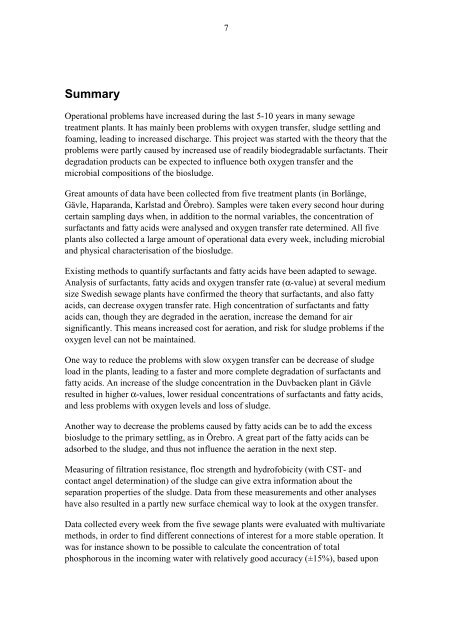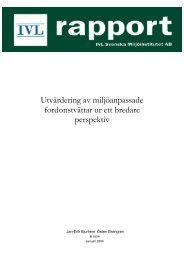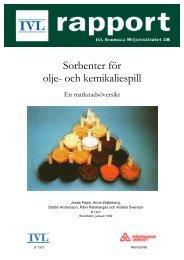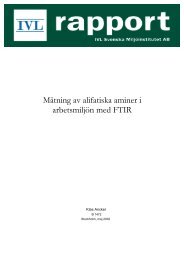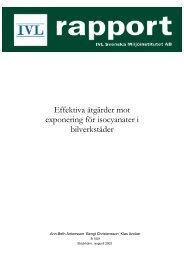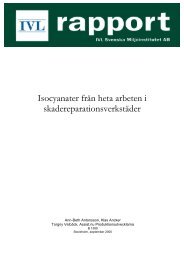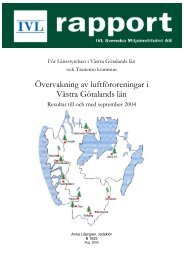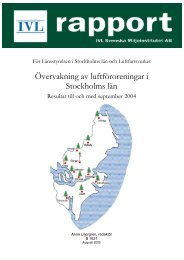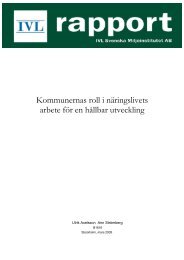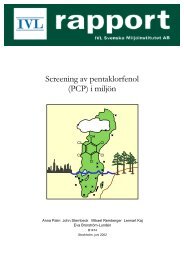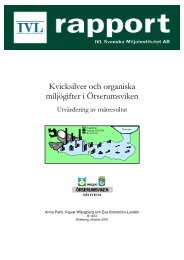DIKA, Driftstörningar i kommunala avloppsreningsverk - en studie av ...
DIKA, Driftstörningar i kommunala avloppsreningsverk - en studie av ...
DIKA, Driftstörningar i kommunala avloppsreningsverk - en studie av ...
Create successful ePaper yourself
Turn your PDF publications into a flip-book with our unique Google optimized e-Paper software.
7SummaryOperational problems h<strong>av</strong>e increased during the last 5-10 years in many sewagetreatm<strong>en</strong>t plants. It has mainly be<strong>en</strong> problems with oxyg<strong>en</strong> transfer, sludge settling andfoaming, leading to increased discharge. This project was started with the theory that theproblems were partly caused by increased use of readily biodegradable surfactants. Theirdegradation products can be expected to influ<strong>en</strong>ce both oxyg<strong>en</strong> transfer and themicrobial compositions of the biosludge.Great amounts of data h<strong>av</strong>e be<strong>en</strong> collected from five treatm<strong>en</strong>t plants (in Borlänge,Gävle, Haparanda, Karlstad and Örebro). Samples were tak<strong>en</strong> every second hour duringcertain sampling days wh<strong>en</strong>, in addition to the normal variables, the conc<strong>en</strong>tration ofsurfactants and fatty acids were analysed and oxyg<strong>en</strong> transfer rate determined. All fiveplants also collected a large amount of operational data every week, including microbialand physical characterisation of the biosludge.Existing methods to quantify surfactants and fatty acids h<strong>av</strong>e be<strong>en</strong> adapted to sewage.Analysis of surfactants, fatty acids and oxyg<strong>en</strong> transfer rate (α-value) at several mediumsize Swedish sewage plants h<strong>av</strong>e confirmed the theory that surfactants, and also fattyacids, can decrease oxyg<strong>en</strong> transfer rate. High conc<strong>en</strong>tration of surfactants and fattyacids can, though they are degraded in the aeration, increase the demand for airsignificantly. This means increased cost for aeration, and risk for sludge problems if theoxyg<strong>en</strong> level can not be maintained.One way to reduce the problems with slow oxyg<strong>en</strong> transfer can be decrease of sludgeload in the plants, leading to a faster and more complete degradation of surfactants andfatty acids. An increase of the sludge conc<strong>en</strong>tration in the Duvback<strong>en</strong> plant in Gävleresulted in higher α-values, lower residual conc<strong>en</strong>trations of surfactants and fatty acids,and less problems with oxyg<strong>en</strong> levels and loss of sludge.Another way to decrease the problems caused by fatty acids can be to add the excessbiosludge to the primary settling, as in Örebro. A great part of the fatty acids can beadsorbed to the sludge, and thus not influ<strong>en</strong>ce the aeration in the next step.Measuring of filtration resistance, floc str<strong>en</strong>gth and hydrofobicity (with CST- andcontact angel determination) of the sludge can give extra information about theseparation properties of the sludge. Data from these measurem<strong>en</strong>ts and other analysesh<strong>av</strong>e also resulted in a partly new surface chemical way to look at the oxyg<strong>en</strong> transfer.Data collected every week from the five sewage plants were evaluated with multivariatemethods, in order to find differ<strong>en</strong>t connections of interest for a more stable operation. Itwas for instance shown to be possible to calculate the conc<strong>en</strong>tration of totalphosphorous in the incoming water with relatively good accuracy (±15%), based upon


